iPad Air vs. Galaxy Tab S7: Which tablet is best?
Which tablet should you buy, the Apple iPad Air or Samsung Galaxy Tab S7?
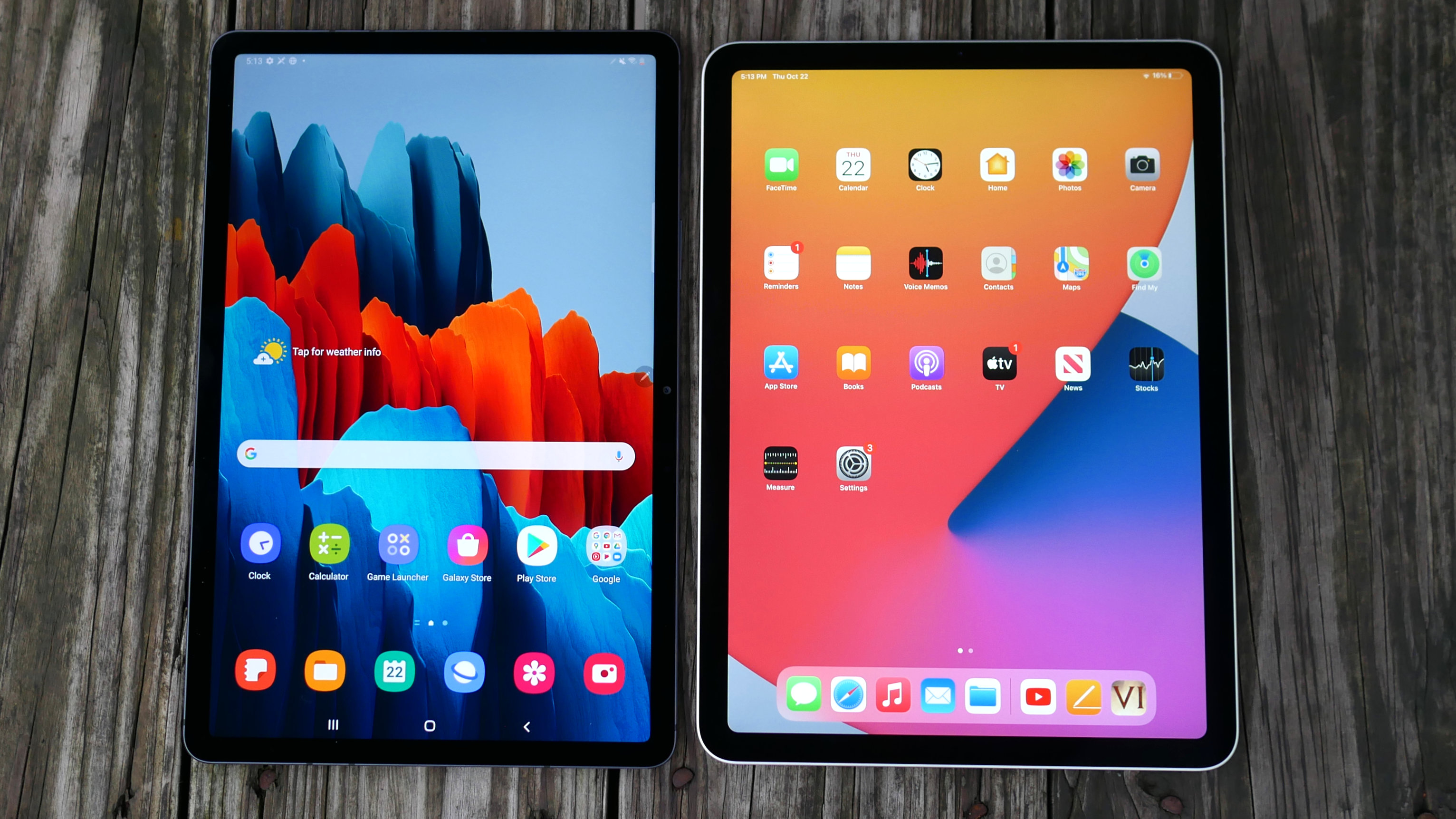
Here is a secret: there are only a handful of tablets I would recommend. Only five or so models are worth your money. The others? You can forget about them. In this face-off, I want to focus on two newly released tablets that give you premium features and specs at a mid-tier price. These top tablets are the iPad Air and the Samsung Galaxy Tab S7. Yes, this is another Apple vs. Samsung showdown, and this time, the winner takes home the Best Tablet belt.
That the Galaxy Tab S7 is even being compared to the iPad Air is an achievement in itself. Android tablets were predicted to become extinct years ago, but instead, Samsung employed the best features of its Galaxy smartphones to deliver another set of successful Galaxy Tab models in the Tab S7 and Tab S7 Plus. To make this a fair comparison, I'm going to focus on the Galaxy Tab S7 as its starting price of $649 more closely matches the $599 iPad Air.
- Best tablets in 2020
- Samsung Galaxy Tab S7 Plus vs. iPad Pro: Which tablet is best?
- iPad vs iPad Air vs iPad Pro vs iPad mini: iPad Buying Guide
Apple isn't making it easy for Samsung. With this latest version, the iPad Air goes from an upgraded entry-level model to a pared-down premium model. What exactly does that mean? The iPad Air is now more similar to the iPad Pro than the regular iPad. The status upgrade was achieved through a redesigned chassis, a larger 10.9-inch display, and Apple's speedy A14 chip.
There is a lot to like about both of these tablets, but there can only be one winner in this face-off. In the battle as old as modern tech, who gets the win, Apple or Samsung? Read on to find out.
iPad Air vs. Galaxy Tab S7: Price and configurations
Starting at $649, the Galaxy Tab S7 is $50 more expensive than the iPad Air. That said, the base Galaxy Tab S7 comes with 128GB of storage and ships with the S Pen included. While cheaper to start, the $599 iPad Air has only 64GB of storage and the optional Apple Pencil costs $129.
Storage upgrades also favor Samsung as the Galaxy Tab S7 can be equipped with 256GB of storage for $729. Upgrading the iPad Air to 256GB storage (there is no 128GB option) jumps the price up to $749.
Samsung also sells the Tab S7 with 512GB of storage for $829. For that storage capacity, you need to buy an iPad Pro, and you don't want to know how much that costs.
Sign up to receive The Snapshot, a free special dispatch from Laptop Mag, in your inbox.
Winner: Galaxy Tab S7.
iPad Air vs. Galaxy Tab S7: Specs
| Row 0 - Cell 0 | iPad Air (2020) | Galaxy Tab S7 |
| Starting price | $599 | $649 |
| Display(resolution) | 10.9 inches (2360 x 1640), 60Hz | 11 inches (2560 x 1600), 120Hz |
| CPU | A14 Bionic | Qualcomm Snapdragon 865+ |
| Storage | 64GB, 256GB | 128GB, 256GB |
| Rear camera(s) | 12MP | 13MP & 5MP |
| Front camera | 7MP | 8MP |
| Battery life | 10:29 | 13:16 |
| Size | 9.7 x 7 x 0.2 inches | 10 x 6.5 x 0.2 inches |
| Weight | 1 pound (Wi-Fi); 1.01 pounds (Cellular) | 1.1 pounds |
| Colors | Silver, space gray, rose gold, green, sky blue | Mystic Black, Mystic Silver and Mystic Bronze |
iPad Air vs Galaxy Tab S7: design
Comparing the designs of these two tablets is like putting an iPhone up against a Samsung Galaxy. They're both gorgeous so it really comes down to your own preferences.
Capturing the signature Apple design, the iPad Air has a sleek aluminum chassis with gently rounded corners and a chrome fruit centered on the back. On the rear is a single prominent camera lens with a mesh speaker grill underneath. The Galaxy Tab S7 is also classy, flaunting brushed edges and a stealthy metal rear cover. Samsung didn't do as good of a job hiding the antenna bands, which wrap around the top and bottom of the slate.

While the back of the iPad Air has an expected design, the front was completely redesigned to look more like the iPad Pro. The Air removes the Touch ID power button from its previously chunky bezels and places a smaller oblong button on the top edge. The Tab S7 similarly has a fingerprint sensor embedded in the side power button; both biometric sensors logged me in quickly but the one on the iPad Air is more pronounced (and, therefore, easier to find).
Moving Touch ID from below the screen allowed Apple to trim down the display bezels (which are now black, not white) in order to increase the screen size from 10.4 inches to 10.9 inches without expanding the tablet's footprint. Samsung's tablet does have slightly thinner bezels (and a larger 11-inch panel) but the difference is negligible.
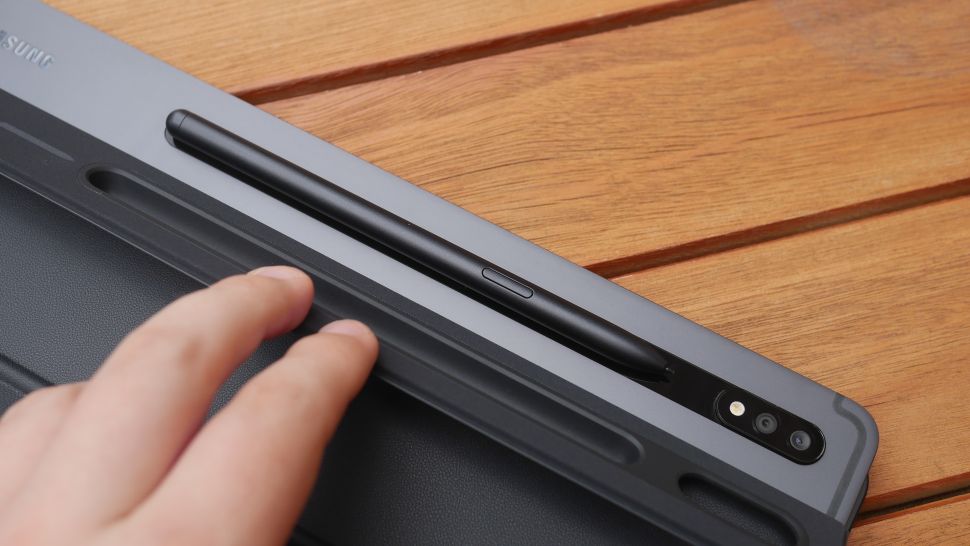
The other key difference between the iPad Air and Galaxy Tab S7 is not how they charge their respective stylii but where they charge them. The Apple Pencil charges by snapping onto the top edge of the iPad Air whereas the S Pen magnetically attaches to a strip on the rear of the Galaxy Tab S7. I prefer Apple's method as it lets you put the iPad down on a flat surface without having to remove the stylus.
Sorry audiophiles, neither tablet has a headphone jack; in a trend nobody asked for, Samsung and Apple executed the 3.5mm jack to push their own truly wireless earbuds and headphones. On the flip side, Apple graciously made the change from Lightning to a USB-C port, found on the bottom edge of the iPad Air. As expected, the Galaxy Tab S7 also charges via USB-C.

Also worth noting is the positioning of the front-facing camera; the camera is on the narrow edge of the iPad Air (for selfies and FaceTime when holding the tablet) and on the longer side of the Galaxy Tab S7 (for taking selfies or video chatting with the keyboard attached).
The iPad Air, at 9.7 x 7 x 0.24 inches and 1 pound, is about the same size and weight as the Galaxy Tab S7 (10 x 6.5 x 0.25 inches, 1.1 pounds).
Winner: Draw.
iPad Air vs Galaxy Tab S7: Displays
Before I talk about color, brightness and the like, one major difference between these displays is their aspect ratios. Apple went with a 3:2 aspect ratio for a taller, more narrow canvas whereas the Galaxy Tab S7 has a wider 16:10 aspect ratio.
My preference leans toward 3:2, but I appreciate how the shapes of the screens are geared toward the tablet's strengths; the Galaxy Tab S7 being great for content viewing and the iPad Air excelling at productivity.
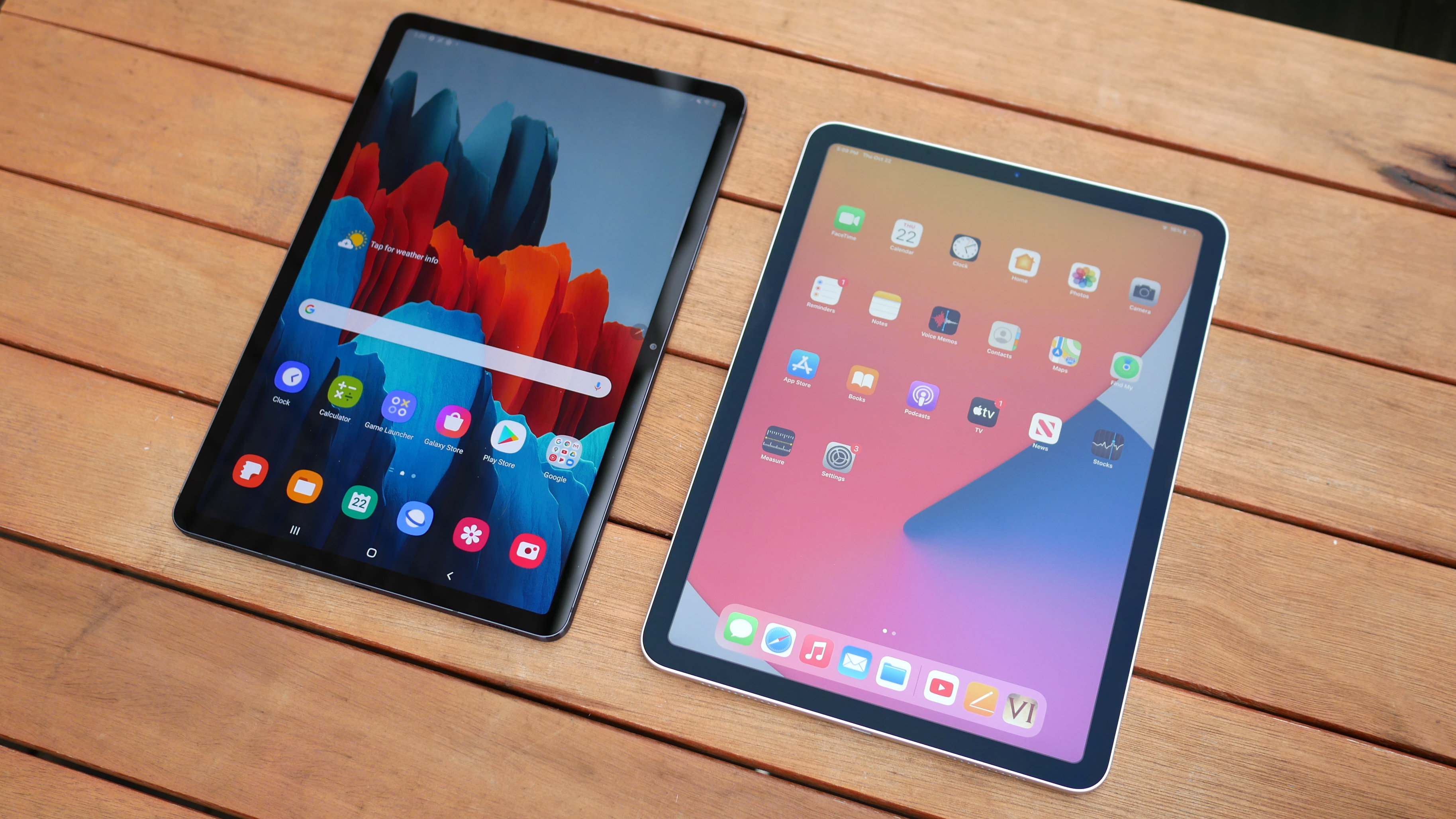
As for display quality, the Galaxy Tab S7's 11-inch, 2560 x 1600-pixel LTPS TFT display is the clear winner. It's brighter, more colorful and has a 120Hz refresh rate (the iPad Air is stuck at 60Hz). When I watched a trailer for Free Guy, the colors on the iPad Air's 10.9-inch, 2360 x 1640-pixel panel were a bit more muted.
Ryan Reynolds’ shirt was a very light baby blue on the iPad whereas, on the Galaxy Tab S7, it looked the proper shade of blue for a dress shirt. A Chevy Camaro looked as if it were recently painted orange on the Samsung, but didn't pop as much on the iPad. I also noticed a tad more detail on the Tab S7 panel when I froze the video on certain scenes.
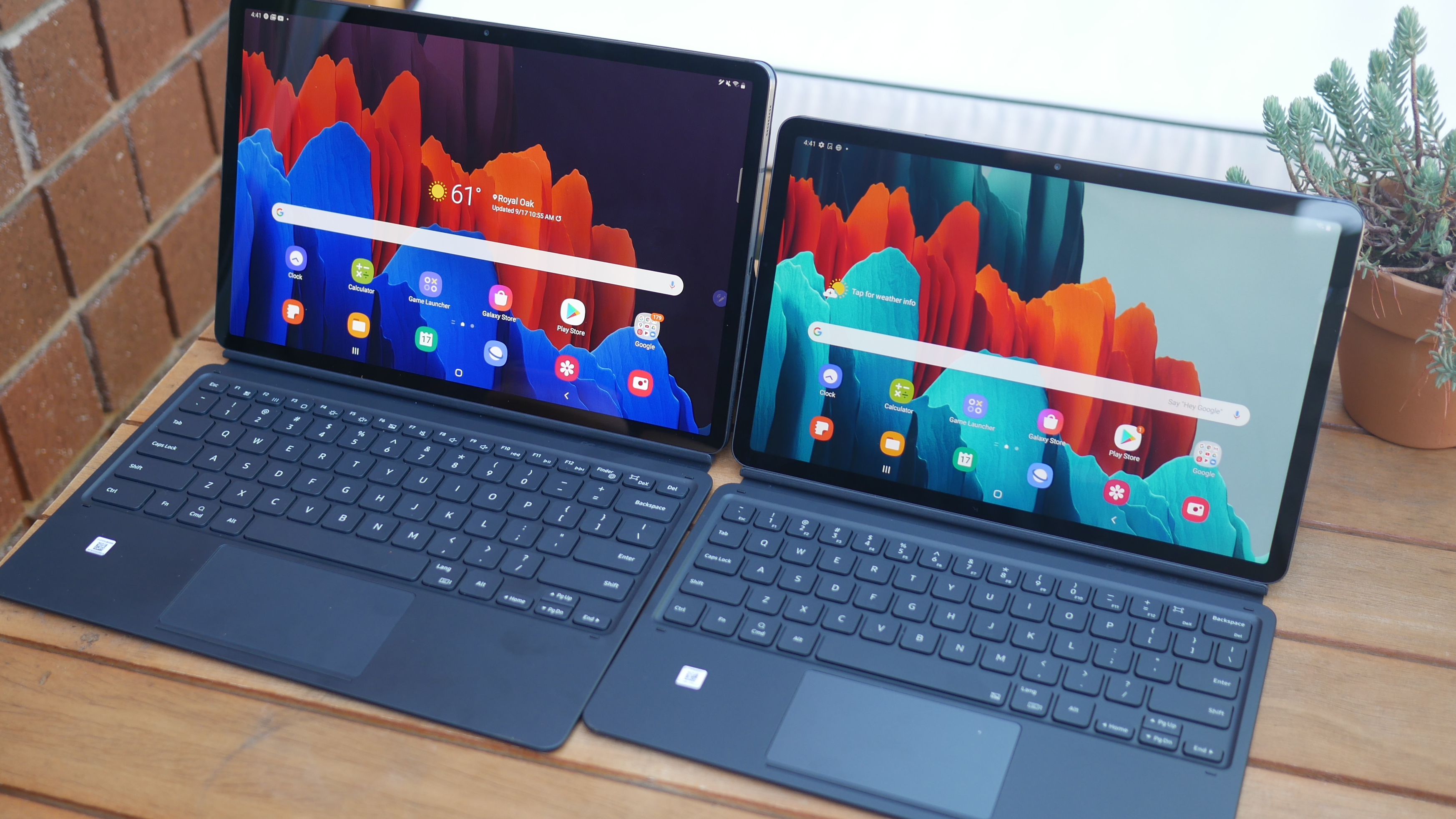
Our display benchmarks didn't surprise. The iPad Air's display covers 102% of the sRGB color gamut, making it less vibrant than the panel on the Galaxy Tab S7 (152%).
With 440 nits of max brightness, the iPad Air's screen is visible outside on bright days but doesn't get quite as bright as the Galaxy Tab S7, which peaked at 499 nits.
Winner: Galaxy Tab S7.
iPad Air vs. Galaxy Tab S7: Keyboard and stylus
Both tablets support a keyboard and stylus but only the Galaxy Tab S7 comes with a pen in the box. And it's not just any generic stylus, the S Pen was upgraded this year with reduced latency from 42 milliseconds to 9 ms. It is also a bit thicker, which makes it more comfortable to hold, although I still find it too thin for my chubby fingers.
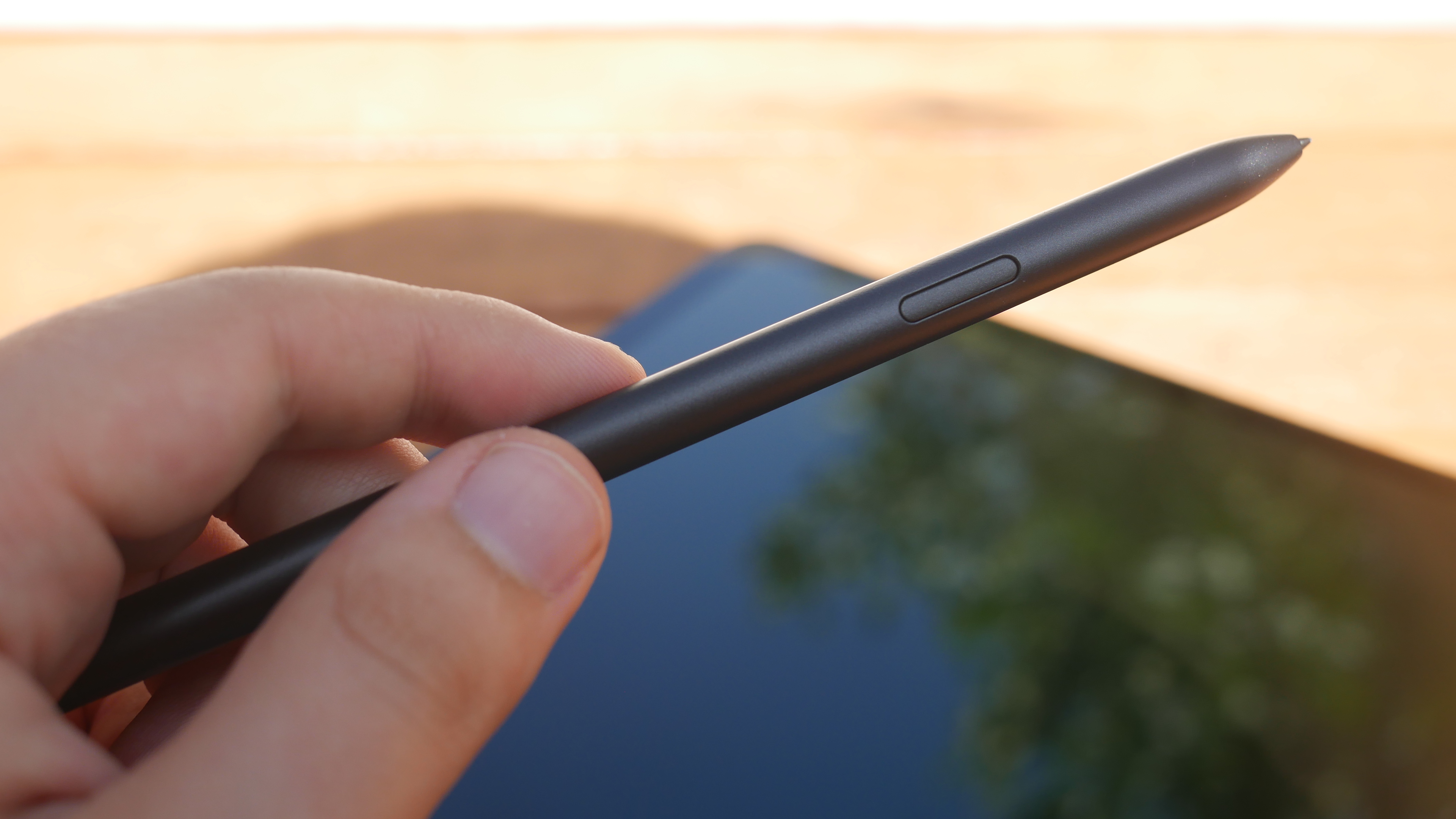
For its part, the iPad Air also supports a 9ms response time but doesn't benefit from the 120Hz refresh rate display. As such, pixel-peepers might notice more of a delay on the iPad when drawing or writing quickly. On the other hand, the Apple Pencil is more ergonomic, with a chunkier body and the flat edge makes it easier to hold. I just find it difficult to praise Apple here; Samsung throws the S Pen in for free while iPad Air owners need to spend an extra $129 for the Apple Pencil.
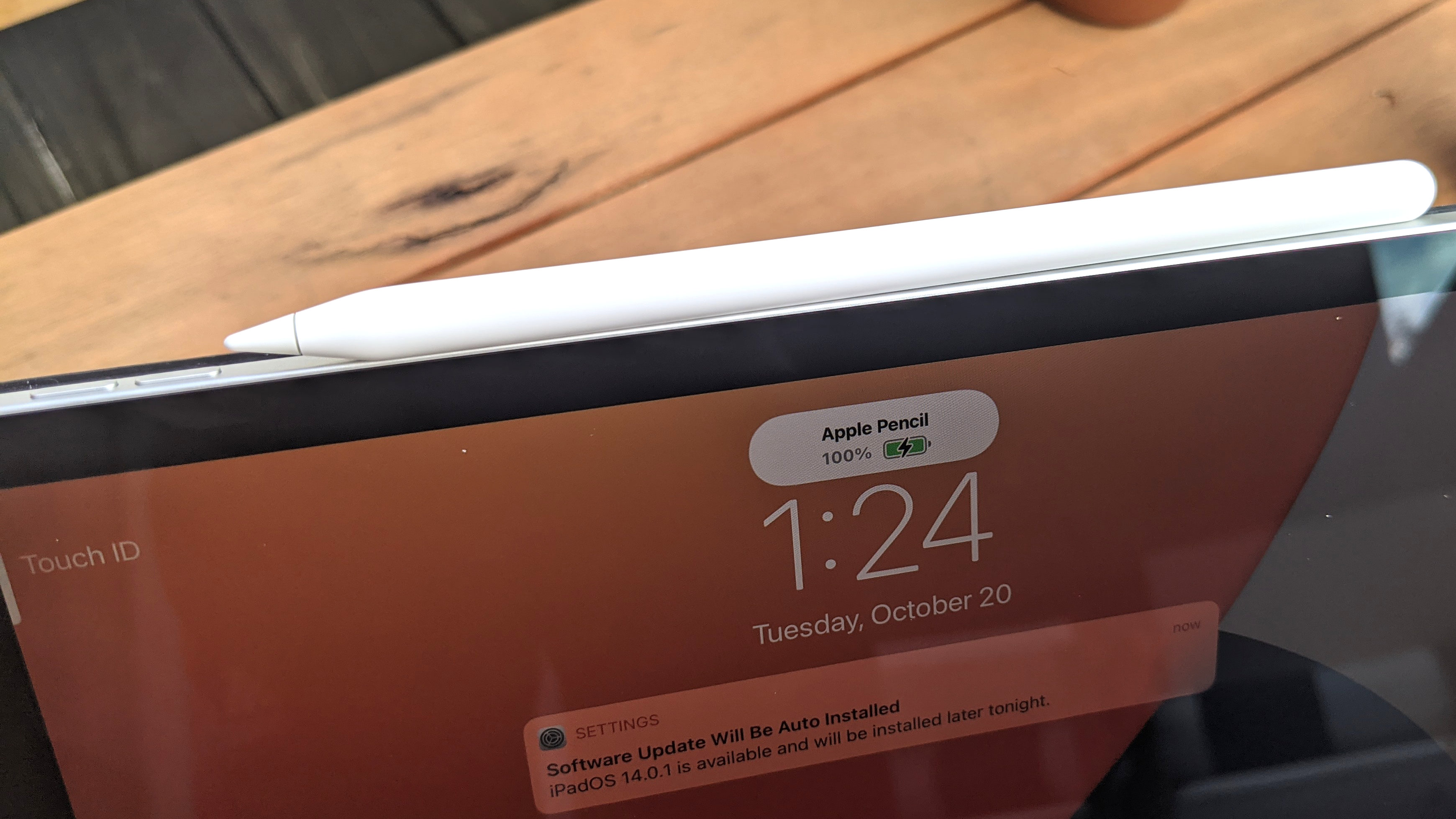
There isn't a great keyboard option between these two tablets. For the Galaxy Tab S7, you can buy the Book Cover keyboard but the one for this 11-inch model (unlike the excellent keyboard for the Tab S7 Plus) isn't very good. It's cramped, several keys are undersized and there is no shortcut row. It also comes in two parts, the rear folio covering as a kickstand, a less elegant solution than the Magic Keyboard's floating hinge.
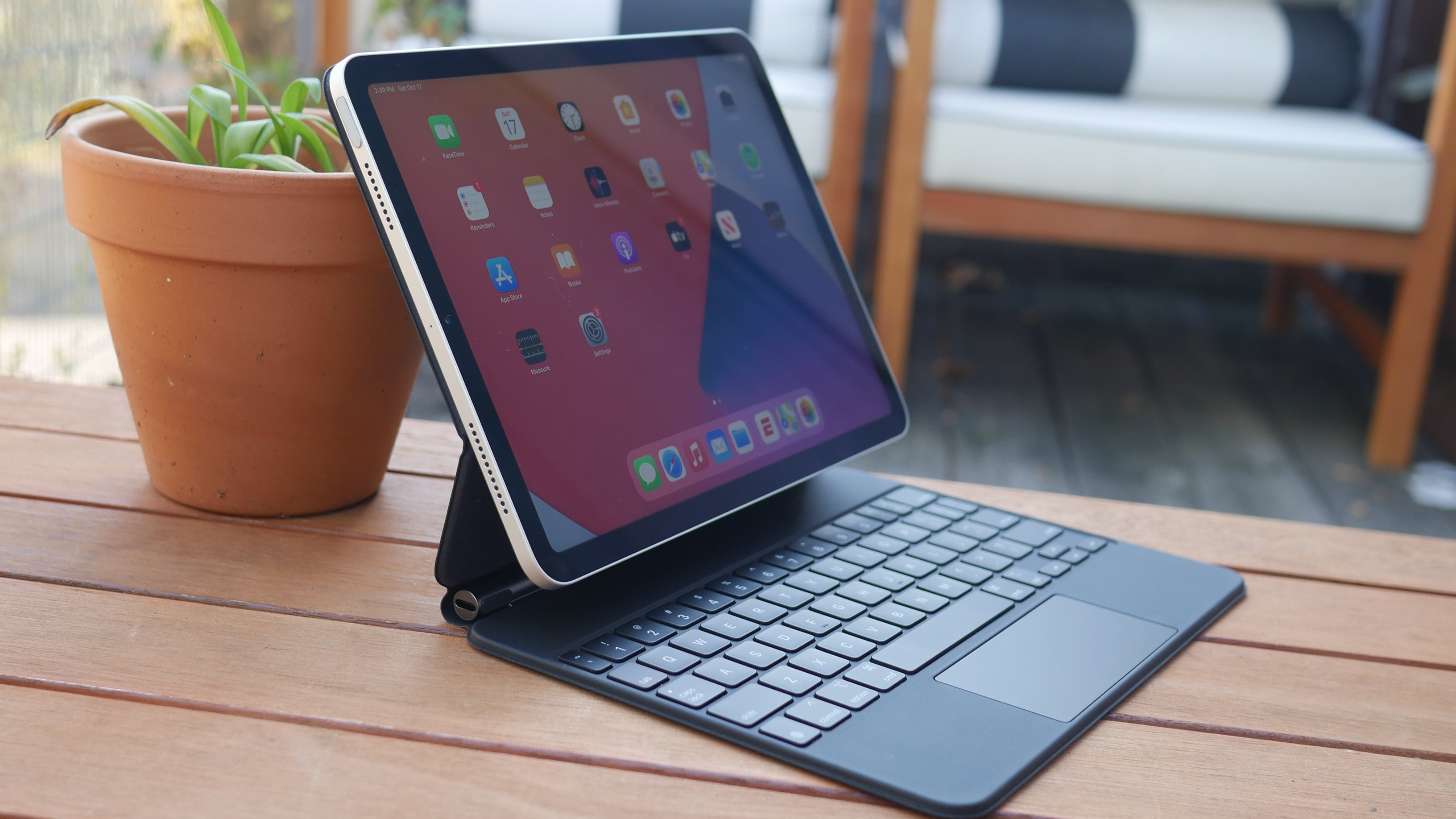
Turning to Apple, you can opt for the $179 Smart Keyboard Folio if you want mushy keys and no backlighting. Then there's the $299 Magic Keyboard. The $299 backlit keyboard is comfortable to type on, it has a clever "floating hinge," and it feels sturdy. But the $299 accessory is also very heavy, you can't use the iPad Air as a tablet when it's attached, and the hinge doesn't rotate as far as I want it to. Also, if I haven't already mentioned, it costs $299.
If it were up to me, I'd buy a Bluetooth keyboard and call it a day. Something like the Lenovo ThinkPad TrackPoint Keyboard II, at $86, puts the others to shame.
Winner: iPad Air (price notwithstanding).
iPad Air vs. Galaxy Tab S7: Performance
These are some of the fastest tablets in the game, capable of running any app you throw at them. I had no problems playing games, running multiple apps and browsing the web on both tablets. I had 20 Chrome tabs open on the Galaxy Tab S7 and didn't notice any lag whatsoever thanks to its Qualcomm Snapdragon 865+ chip. The iPad Air was just as snappy to load multiple web pages while YouTube Music played in the background.

When it comes to benchmarks, the iPad Air, powered by Apple's A14 Bionic chip, is in a league of its own. As such, power users or those who plan to use a tablet as their primary device, might be better off with the Air. The Air scored a 4,262 on the Geekbench 5 overall performance test, which crushes the Galaxy Tab S7's 3,074.
Winner: iPad Air.
iPad Air vs. Galaxy Tab S7: Battery life
Both tablets charge using USB Type-C, but there is a clear winner when it comes to battery life, and no, it isn't the Apple.

Surprised? I know. The iPad Air did a great job on our runtime test (continuous web surfing over Wi-Fi at 150 nits), enduring for 10 hours and 29 minutes. However, the Galaxy Tab S7 remained powered for 13 hours and 8 minutes, far longer than the 10:58 category average.
Winner: Galaxy Tab S7.
iPadOS 14 vs. Android 10 + DeX
OS preference is highly subjective but it's worth pointing out the pros and cons of iPadOS and Android.
With iPadOS 14, the iPad Air blends the simplicity of iOS with the productivity of macOS. Redesigned widgets now come in various sizes and show more information. A new feature called Smart Stack uses AI to automatically surface the best widgets at the right time based on your time, location and activity.

Apple also revamped the sidebar on apps to optimize the info being displayed. Photos, Music, Shortcuts, Voice Memos, Calendar and more now have drop-down or sidebar menus where you'll find relevant tools and controls. The iPad allows you to view three apps at once with slip-view modes or picture-in-picture.
The Galaxy Tab S7 runs Android 10 out of the box alongside Samsung DeX. For the uninitiated, DeX is Samsung's custom desktop interface designed to make the Tab S7 feel more like a laptop so you don't have to stop using your tablet when it's time to get some work done.
The main DeX interface will look familiar to those who have used a Windows 10 PC or Chromebook. There is a taskbar at the bottom of the screen where you can pin apps, otherwise, they stay as shortcuts on the home screen.
Unfortunately, certain Android apps and interfaces don't scale well on a tablet — large black bars flank the usable screen space on un-optimized apps.
Overall winner: iPad Air

I'm really impressed by the Galaxy Tab S7 after comparing it side-by-side against the iPad Air. It has a better display, longer battery life and cheaper accessories (the S Pen is included!). For these reasons, the Tab S7 is an excellent option for those who want a tablet to consume content or draw by hand.
But the best overall tablet is the iPad Air, if by the narrowest of margins. Apple's slate tops the Galaxy Tab S7 with outstanding performance and top-notch accessories (although they're very expensive). iPadOS is also more flexible than Android + DeX, and most importantly, its apps are better optimized for larger displays.
That being said, if you're on a tight budget and need a stylus, the Galaxy Tab S7 is the tablet to buy. It's also the best tablet for streaming Netflix or watching YouTube videos, and it still allows you to do light productivity with Samsung DeX. For those who want a tablet as a primary device or find themselves splitting their time evenly between work and play, the iPad Air is the one to get.
Phillip Tracy is the assistant managing editor at Laptop Mag where he reviews laptops, phones and other gadgets while covering the latest industry news. After graduating with a journalism degree from the University of Texas at Austin, Phillip became a tech reporter at the Daily Dot. There, he wrote reviews for a range of gadgets and covered everything from social media trends to cybersecurity. Prior to that, he wrote for RCR Wireless News covering 5G and IoT. When he's not tinkering with devices, you can find Phillip playing video games, reading, traveling or watching soccer.

